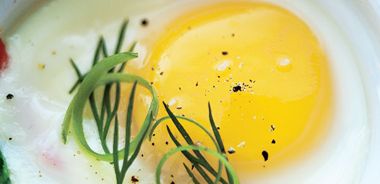Christmas Eggs en Cocotte

The classic French name is oeufs en cocotte and is traditionally eggs baked in little ramekins very simply or with a choice of little mixtures and cream. We’ve stepped up the mix by adding festive colours of vegetables and crème fraîche.
1 Tbsp (15 mL) unsalted butter
1/4 cup (60 mL) very finely minced green onions
1/4 cup (60 mL) very finely minced red bell pepper
2 Tbsp (30 mL) very finely minced carrot
1 cup (250 mL) loosely packed baby spinach leaves, washed and spun dry
4 oz (115 g) thinly sliced cold smoked salmon, cut into strips
8 large eggs
1/2 cup (125 mL) crème fraîche
4 tsp (20 mL) unsalted butter
Salt and freshly ground black pepper
Fresh dill and curled green onion
Preheat oven to 375 F (190 C).
Place 8 - 1/2 cup (125 mL) ramekins in baking dish large enough to hold them, allowing a little space in between. Lightly grease inside of each ramekin.
In small sauté pan melt 1 Tbsp (15 mL) butter. Add green onions, red pepper, and carrot and sauté for a couple of minutes to soften.
Divide mixture among ramekins. Top with spinach and smoked salmon. Crack an egg on top of each, then top with 1 Tbsp (15 mL) crème fraîche. Dot each with 1/2 tsp (2 mL) butter and sprinkle with a little salt and pepper. Pour hot water into baking dish until it is halfway up the sides of the ramekins.
Carefully place baking dish in preheated oven and bake for 10 to 12 minutes, or until eggs are slightly soft and set. Garnish with dill and a curl of green onion and serve with focaccia and baby green salad on the side.
Serves 8.
Each serving contains: 114 calories; 9 g protein; 8 g total fat (3 g sat. fat, 0 g trans fat); 2 g carbohydrates (1 g sugars, 0 g fibre); 198 mg sodium
Options
Dairy free: Should there be a request for dairy free, use extra-virgin olive oil in place of butter and dot with a little plain soy yogourt or soy milk before baking.
Vegetarian: Leave out the smoked salmon and add a little more salt and pepper.
To save time: Assemble ramekins the night before, adding eggs and crème fraîche just before baking.
source: "Festive Brunch fo Savour", alive #362, December 2012





